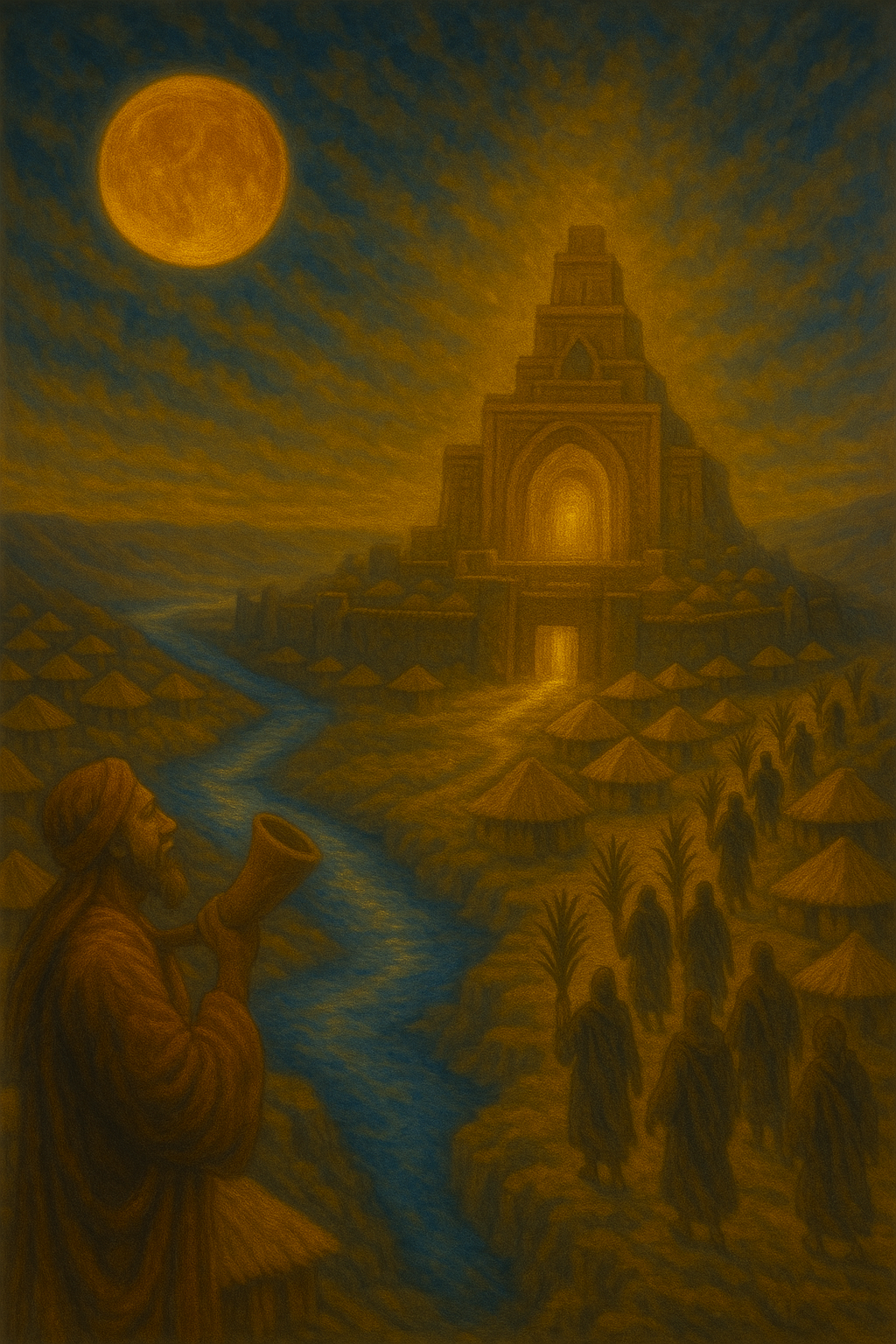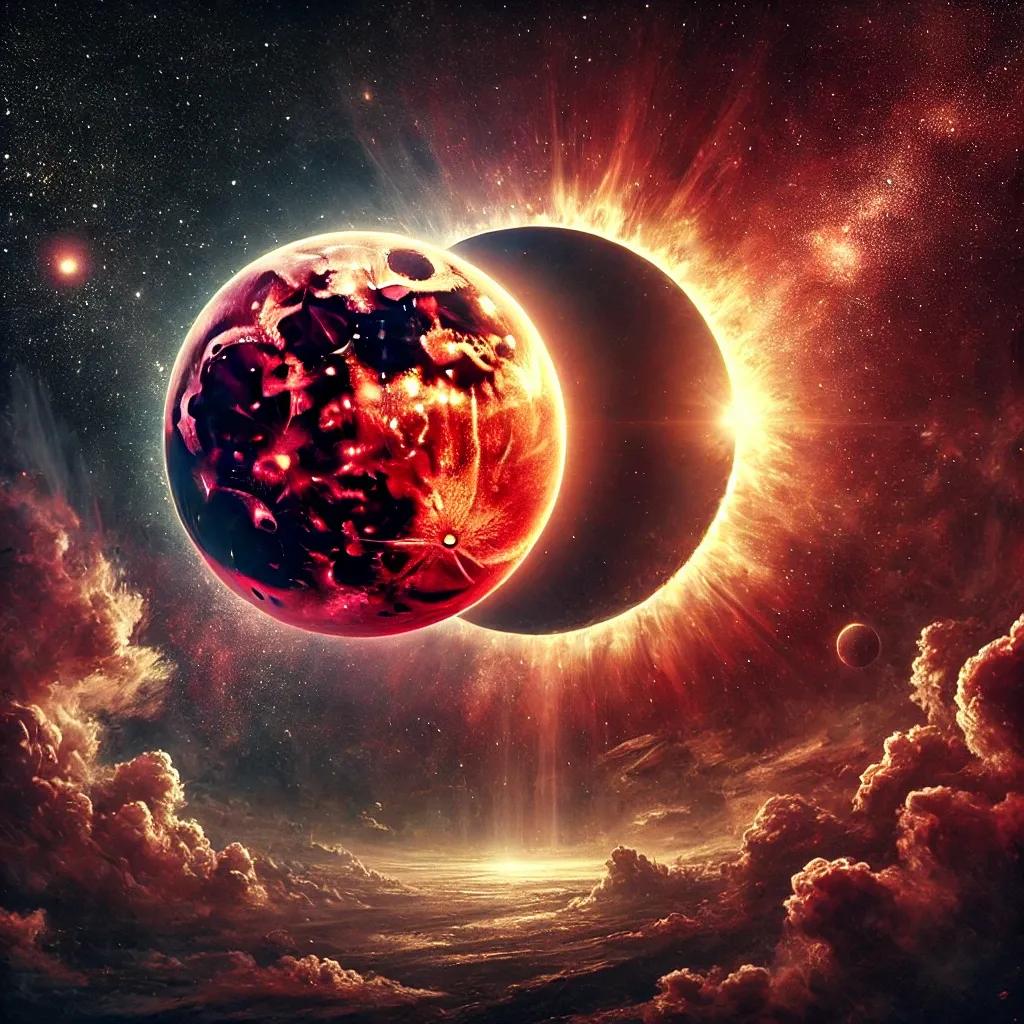Sukkot

"The LORD will be king over the whole earth. On that day there will be one LORD, and his name the only name." — Zechariah 14:9
⸻
Prologue: The Feast of Divine Dwelling
In the autumn of 2033, as the harvest moon rises over Jerusalem, humanity will witness what the patriarchs only glimpsed in shadow—the literal tabernacling of YHWH with His people. For seven years, the earth has groaned through Daniel's final week. But on Yom Kippur 2033 (October 3), the heavens split, the King returns, and the great Day of Atonement finds its ultimate fulfillment. Then, just five days later, on the 15th of Tishrei (October 8, 2033), the Feast of Tabernacles begins—not as memorial but as reality, not as type but as antitype, not as promise but as presence.
⸻
Part I: The King Descends to Tabernacle
From Eden onward, God has sought to dwell with His people. He walked with Adam in the garden's cool. He descended in fire at Sinai. He filled the Tabernacle with glory and later the Temple with His presence. Yet all these were but preludes to the ultimate indwelling prophesied by Zechariah:
"And the LORD will be king over all the earth. On that day the LORD will be one and his name one... Then everyone who survives of all the nations that have gone against Jerusalem shall go up year after year to worship the King, the LORD of hosts, and to keep the Feast of Booths." — Zechariah 14:9, 16
Sukkot 2033 marks the inauguration of this divine tabernacling. Christ, having returned in glory, now establishes His throne in Jerusalem. The temporary booths that Israel built for centuries—those fragile reminders of wilderness wandering and divine provision—give way to the eternal reality: God Himself dwelling permanently among men.
John saw this day in vision:
"And I heard a loud voice from the throne saying, 'Behold, the dwelling place of God is with man. He will dwell with them, and they will be his people, and God himself will be with them as their God.'" — Revelation 21:3
Though John's vision ultimately points to the eternal state, the Millennial Kingdom serves as its glorious prelude—a thousand-year Sukkot where Christ tabernacles on earth in resurrected glory.
⸻
Part II: Jerusalem Transformed—YHWH Shammah
Ezekiel's final vision reaches its fulfillment as Jerusalem receives its ultimate name:
"The circumference of the city shall be 18,000 cubits. And the name of the city from that time on shall be, The LORD Is There [YHWH Shammah]." — Ezekiel 48:35
No longer merely the city of David or even the holy city, Jerusalem becomes the dwelling place of the visible YHWH. The Shekinah glory that once hovered between the cherubim now radiates from the throne of the Son of David. The city itself becomes a living sukkah—a booth where the divine presence dwells not in symbolic cloud and fire but in the Person of the glorified Christ.
Isaiah had foreseen this transformation:
"It shall come to pass in the latter days that the mountain of the house of the LORD shall be established as the highest of the mountains, and shall be lifted up above the hills; and all the nations shall flow to it." — Isaiah 2:2
The physical topography changes—Jerusalem elevated, the Mount of Olives split (Zechariah 14:4), living waters flowing east and west (Zechariah 14:8). But more than geological transformation, this is theological fulfillment: the place where God's name dwells becomes the center of all earthly worship, the capital not just of Israel but of the cosmos.
⸻
Part III: The Nations' Pilgrimage to Keep the Feast
Zechariah's prophecy establishes a new world order centered on Sukkot observance:
"Then everyone who survives of all the nations that have gone against Jerusalem shall go up year after year to worship the King, the LORD of hosts, and to keep the Feast of Booths. And if any of the families of the earth do not go up to Jerusalem to worship the King, the LORD of hosts, there will be no rain on them." — Zechariah 14:16-17
This is not mere religious observance but recognition of reality. The nations come to Jerusalem because that is where the King dwells—literally, visibly, tangibly. They keep Sukkot because they are acknowledging the great truth the feast proclaims: God tabernacles with humanity. Those who refuse this pilgrimage deny not just a religious duty but the fundamental reality of the Kingdom age—that YHWH dwells on earth.
The ancient harvest celebration takes on new meaning. The nations bring not just agricultural firstfruits but the tribute of submitted hearts. The temporary booths they construct remind them that even in the Kingdom age, they are dependent on the King who tabernacles among them. The joy that always characterized Sukkot—"the season of our rejoicing"—reaches its apex as humanity celebrates the presence of their Maker.
⸻
Part IV: The Millennial Sabbath—Creation's Rest
With Sukkot 2033 begins not just a feast but an age—the seventh millennium from creation, the cosmic Sabbath for which all history has yearned. The writer of Hebrews glimpsed this truth:
"So then, there remains a Sabbath rest for the people of God, for whoever has entered God's rest has also rested from his works as God did from his." — Hebrews 4:9-10
The pattern embedded in creation week finds its fulfillment:
- Days 1-6: Six thousand years of human labor and divine redemptive work
- Day 7: The thousand-year rest when the Son of God reigns from Jerusalem
This is why the Millennium begins with Sukkot—the feast that combines harvest celebration with Sabbath rest. For one thousand years, creation itself experiences what every seventh day, seventh year, and fiftieth year foreshadowed: divine rest in divine presence.
Paul revealed that creation groans for this very moment:
"For the creation waits with eager longing for the revealing of the sons of God... in hope that the creation itself will be set free from its bondage to corruption and obtain the freedom of the glory of the children of God." — Romans 8:19, 21
The Millennial Sukkot answers this groaning. The curse lifts, the desert blooms, the wolf dwells with the lamb (Isaiah 11:6-9). Earth keeps Sabbath because the Lord of the Sabbath dwells in Jerusalem.
⸻
Part V: The Ultimate Jubilee Fulfilled
Sukkot 2033 inaugurates not just a Sabbath but history's ultimate Jubilee. Consider the mathematical precision: From Israel's entry into the land (approximately 1406 BC) to the Millennium spans roughly 70 Jubilee cycles—the very number of completion Daniel received in his vision of seventy weeks.
The Jubilee's requirements find perfect fulfillment:
- Liberty proclaimed: Satan bound, humanity freed from deception (Revelation 20:1-3)
- Return to inheritance: Israel fully restored to their land, the nations receive their King
- Debts forgiven: The sin question settled forever at Calvary now manifests in global righteousness
- Land rests: Creation itself sabbaths under the reign of the Second Adam
Jesus had read from Isaiah 61 at the beginning of His ministry: "to proclaim the year of the LORD's favor" (Luke 4:19). He stopped mid-verse, not reading "and the day of vengeance of our God" (Isaiah 61:2). The first coming announced Jubilee; the second coming enforces it. Sukkot 2033 begins the Jubilee that never ends—not just fifty years but a thousand, and then eternity.
⸻
Part VI: Christ as High Priest and King—The Feast Fulfiller
In the Millennial Temple, Christ serves in a capacity no previous priest could claim:
"The LORD has sworn and will not change his mind, 'You are a priest forever after the order of Melchizedek.'" — Psalm 110:4
Melchizedek was both priest and king of Salem (Jerusalem). Christ now fulfills this dual office perfectly. As High Priest, He has already offered the perfect sacrifice (Himself). As King, He rules from David's throne. The feasts, which always pointed to Him, now find their meaning in His presence:
Spring Feasts—Fulfilled at First Coming:
- Passover: His crucifixion
- Unleavened Bread: His sinless burial
- Firstfruits: His resurrection
- Pentecost: The Spirit poured out
Fall Feasts—Fulfilled at Second Coming:
- Trumpets: The resurrection and rapture (Rosh Hashanah 2026)
- Atonement: His return in judgment (Yom Kippur 2033)
- Tabernacles: His millennial reign (Sukkot 2033-3033)
But now, with Christ on earth, the feasts transform from memorial to encounter. When the nations come up for Sukkot, they do not merely remember God's provision—they meet the Provider. When they build their booths, they do not merely recall wilderness wanderings—they acknowledge their King who tabernacles among them.
⸻
Part VII: YHWH Himself on the Throne
The ultimate mystery of Sukkot 2033 is the identity of the One on the throne. John records the heavenly song:
"The kingdom of the world has become the kingdom of our Lord and of his Christ, and he shall reign forever and ever." — Revelation 11:15
Yet Zechariah speaks singularly: "And the LORD will be king over all the earth" (14:9). The resolution comes in recognizing what Thomas confessed: "My Lord and my God!" (John 20:28). The Christ who reigns from Jerusalem is YHWH incarnate, the Word made flesh now dwelling (tabernacling) among us in unveiled glory.
This is why the nations must come to Jerusalem for Sukkot. It is not merely to honor a victorious king but to worship YHWH Himself. The Shekinah glory that dwelt between the cherubim now radiates from the incarnate Son. The divine name that could not be spoken now has a face—the face of Jesus Christ, in whom "the whole fullness of deity dwells bodily" (Colossians 2:9).
⸻
Part VIII: The Eternal Feast Begins
As the first Millennial Sukkot unfolds in October 2033, pilgrims from every nation ascend to Jerusalem. They come not in fear but in joy, not under compulsion but in celebration. For the first time since Eden, humanity celebrates Sukkot in the immediate presence of God.
The booths they build whisper the greater truth—God Himself has built His booth among men. The palm branches they wave celebrate victory greater than Maccabees or Exodus—victory over death itself. The water ceremonies that once prayed for rain now celebrate the river of life flowing from the throne. The light ceremonies that once pierced temple darkness now honor the Light of the World reigning in unveiled splendor.
Every family brings their offerings, every nation its tribute, every heart its worship. And from the throne comes the response—the blessing of the One who chose to tabernacle among His people, the King who is Himself YHWH, the Priest who is Himself the sacrifice, the Host who is Himself the feast.
⸻
Epilogue: When Every Day Becomes Sukkot
The Feast of Tabernacles 2033 begins a thousand-year celebration. Though the nations return annually for the feast, in a deeper sense, every day of the Millennium is Sukkot—for the divine presence never departs. Jerusalem remains YHWH Shammah. The King remains on His throne. The tabernacling of God with humanity, begun in October 2033, continues until it flows seamlessly into the eternal state where God will be "all in all" (1 Corinthians 15:28).
The booths of palm and myrtle give way to the eternal city. The celebration of harvest yields to endless abundance. The joy of the feast becomes the joy of forever. For when YHWH tabernacles with His people, Sukkot never truly ends—it only grows more glorious with each passing day of the great Millennial Sabbath, until time itself yields to eternity, and the feast becomes forever.


Comments ()